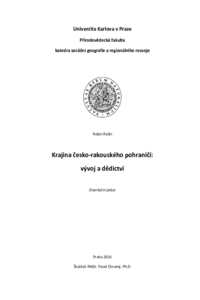Krajina česko-rakouského pohraničí: vývoj a dědictví
The Landscape of the Czech-Austrian Borderland: Development and Heritage
rigorózní práce (UZNÁNO)

Zobrazit/
Trvalý odkaz
http://hdl.handle.net/20.500.11956/33225Identifikátory
SIS: 99664
Katalog UK: 990012896480106986
Kolekce
- Kvalifikační práce [21483]
Autor
Fakulta / součást
Přírodovědecká fakulta
Obor
Regionální a politická geografie
Katedra / ústav / klinika
Katedra sociální geografie a region. rozvoje
Datum obhajoby
10. 12. 2010
Nakladatel
Univerzita Karlova, Přírodovědecká fakultaJazyk
Čeština
Známka
Uznáno
Klíčová slova (česky)
krajina, změny ve využití ploch, dědictví, pohraničí, Česko, RakouskoKlíčová slova (anglicky)
Landscape;Land Use;Land Cover;Heritage;Borderland;Czechia;AustriaPředkládaná práce je příkladem výzkumu přeshraničních krajin v oblasti česko-rakouského pohraničí. Zabývá se historicko-geografickou analýzou vývoje makro- i mikrostruktury krajiny s dvěma hlavními cíli. Prvním byla snaha o nalezení společných/odlišných rysů ve formování pohraniční krajiny Česka a Rakouska v době bipolárně rozdělené Evropy. Druhým cílem práce byla snaha o podchycení stabilních prvků v mikrostruktuře krajiny. Navržený postup identifikace vybraných stabilních prvků v krajině by mohl být využit jako základ pro humanisticky orientovaný výzkum krajiny. K nalezení odpovědí na výzkumné otázky byly použity statistické prameny a také mapové podklady a ortofota. Vstupní data byla analyzována a vyhodnocena pomocí již známých ukazatelů, ale byly vyvinuty i nové ukazatele a postupy hodnocení krajiny. Výsledky ukazují, že na úrovni makrostruktury byl vývoj krajiny v českém i rakouském pohraničí velmi podobný - např. struktura využití půdního fondu, její změny. Zcela odlišné výsledky nám poskytuje studium mikrostruktury krajiny - např. změny velikostní struktury orných ploch. Práce ukázala jasnou potřebu detailního studia krajiny, které dokáže lépe postihnout vývojové odlišnosti a strukturální "viditelné" změny v krajině. Ukázalo se také, že studium stabilních prvků krajiny se může stát vhodnou...
The presented study is an example of the research of trans-boundary landscapes underwent in the exemplary area of the Czech-Austrian borderland. In the focus of the research was the history-geographical analysis of landscapes' macro- and microstructure. The research had two main objections. Firstly, we tried to identify shared/different features of the Czech and Austrian landscapes development during the era of politically sharply divided Europe. Secondly, we paid attention to stabile landscape features. The proposed procedure of identification of stabile landscape features can be used as a basis for humanistic orientated landscape research. In order to answer the research questions, we used data of several sources - statistical evidence, historical maps, aerial photographs. The data were analyzed and evaluated by previously published as well as newly developed indexes. The results show that the development of landscape macrostructure was very similar on both Czech and Austrian side of the borderland - e.g. land use structure and its development over the selected time period. However, the research of the landscape microstructure provided a proof of different landscape formation when compared Czech and Austrian borderland - e.g. arable land areal index. The study pointed out the obvious need for a...
